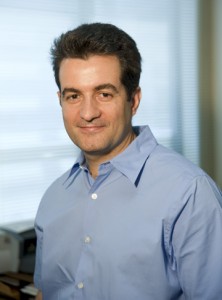By dejoseph
New Research Could Help Trace Source of Bioterror Agents
By Mark Dwortzan
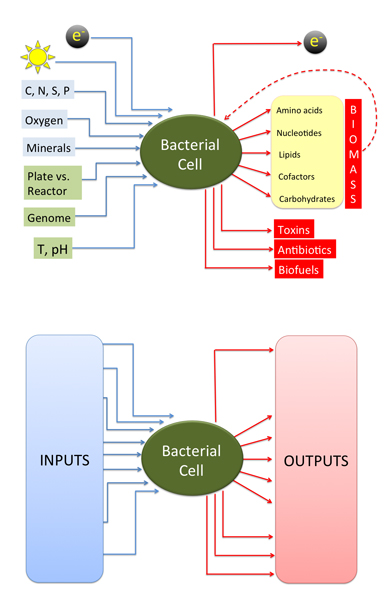
A bacterial cell receives several inputs from its environment, including the availability of different nutrients and the ambient temperature and pH. Based on these inputs, a bacterium controls its growth rate and molecular composition, which can be thought of as the output of the system. By combining experimental measurements and mathematical models, Paschalidis and Segre aim to gradually dcode this input-output relationship and thereby predict the output given the input or vice versa, enabling researchers to track the source of potential pathogens.
Through genetic manipulation or growth in the laboratory, microbes can be engineered for either harmful aims, such as anonymous anthrax attacks, or beneficial purposes, such as vaccines, fuel cells or pollution control systems. A better understanding of how the conditions in which a bacterial cell is grown impact its metabolism and biochemical composition could lead to new tools to help counter potential bioterror threats and advance the development of a wide range of peaceful applications.
Now an interdisciplinary team of systems engineers, computer scientists, microbiologists and biochemists—including Boston University researchers (Professor Yannis Paschalidis (ECE, SE) and Associate Professor Daniel Segrè (Biology, BME, Bioinformatics), as well as the University of Texas and Harvard University—seeks to establish clear links between bacterial cells’ growth conditions and their resulting composition by developing and testing advanced mathematical methods. Funded by a $7.5 million grant from the U.S. Army Research Office, the five-year project could lead to new ways to track the source of a bacterial pathogen, and to help discriminate between natural infectious outbreaks and the deliberate spread of pathogens.
Bacterial cells are typically grown in a nutrient-rich broth containing all the raw materials they need to grow and multiply. The growth medium and environmental factors particular to a lab, such as temperature or pH, constitute the growth conditions that collectively influence the metabolism and biochemical composition of a microorganism. To draw links between a bacterial cell’s growth conditions and its current composition, the researchers plan to model the cell as a system with inputs (growth conditions) and outputs (cell composition), and devise a functional mapping, or mathematical formulas, that transform inputs to outputs and vice versa.
Paschalidis plans to apply optimization techniques to produce these mappings.
“If we observe the cell composition, what can we say about the environment and growth factors impacting that composition?” he says. “The challenge in identifying the source of a bioterror attack is to solve this problem and infer the input from the output.”
Segrè, an expert in the use of mathematical models to drive biological discovery, will develop computer simulations of microbial metabolism and growth under a wide range of possible laboratory conditions. Based on these simulations and experimental measurements to validate their accuracy, Paschalidis will infer how various growth conditions impact the composition of a bacterial cell.
“The composition of the microbial cell may carry information on where it grew and how it evolved, like a hidden signature, that we will try to characterize and interpret,” Segrè observed. “If a bacterium grew under unusual circumstances, or was artificially evolved in a lab, this will likely be reflected in the cell composition.”
Cyber-Security Research
By Rachel Harrington
As people grow more dependent on computers for everything from accessing their bank accounts to storing sensitive information, cyber security has become an increasingly important research area.
At Boston University, Professor Ioannis Paschalidis (ECE) is hoping to improve upon computer data protection by developing an effective way to detect intrusions into private networks and any exfiltration of sensitive or classified information.
“Cyber attacks not only can compromise classified information – whether military, government, or corporate – but also cripple the nation’s key infrastructure – including financial institutions, telecommunications, air-traffic control, and the electricity grid,” said Paschalidis. “Being able to detect such attacks is an important first step to effective counter-measures.”
The U.S. Army Research Office seemed to agree with his sentiments recently when they awarded $600,000 to his project, “A Coordinated Approach to Cyber-Situation Awareness Based on Traffic Anomaly Detection.”
Paschalidis, the principal investigator (PI) on the project, will work closely with Co-PIs, BU professors, Christos Cassandras (ECE) and Mark Crovella (CS), and Paul Barford from the University of Wisconsin.
The team aims to build upon their previous research in order to develop a series of anomaly detection algorithms and tools that will monitor network traffic and operate at both local and global levels. To improve counteraction, input will be processed by a clustering/pattern recognition approach that will identify and classify specific cyber attack scenarios.
Looking forward to partnering with the Army Research Office, Paschalidis said, “This collaboration will provide us with real examples of attacks we can leverage to improve our methods.”
Flight Lessons From Bats, Birds and Insects
ENG Faculty, Alum Partner in $7.5M Grant to Develop Bio-Inspired Aerial Vehicles
By Mark Dwortzan
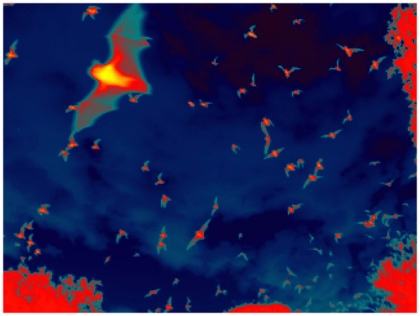
High-resolution thermal image of bats in flight. Such images will be used to develop flight control algorithms approximating bat flight. (Image courtesy of Tom Kunz, BU professor of biology)
Can studying the flight dynamics of bats, birds and insects lead to a new generation of unmanned aerial vehicles that can navigate more effectively in cluttered environments? To maneuver as well as winged animals in tight places such as forests and caves, and land as safely on variable and moving terrain, an engineered system would have to incorporate unprecedented sensing and control capabilities while satisfying complex physical design, weight and computational requirements.
Aiming to build a process for translating biological capabilities for agile flight in a range of environments for engineered flight vehicles, the Office of Naval Research (ONR) has awarded a five-year, $7.5 million grant to a team of researchers from Boston University, the University of Washington, the University of Maryland and the University of North Carolina at Chapel Hill.
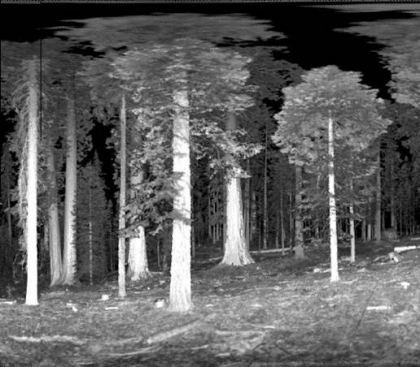
Computer reconstruction of a 3-D Lidar image. Images of actual animal habitats will be used to reconstruct animal flight paths through the imaged habitats. (Image courtesy of Xiaoyuan Yang, a graduate student in the BU Department of Geography and Environment.)
Operating under a $3.1 million subcontract, the Boston University team includes Professors John Baillieul (ME) and Ioannis Paschalidis (ECE) and Assistant Professor Calin Belta (ME) in the College of Engineering; and Thomas Kunz, professor of biology, and Margrit Betke, associate professor of computer science, in the College of Arts & Sciences. The project’s principal investigator, Kristi Morgansen, associate professor of aeronautics and astronautics at the University of Washington, received her B.S. and M.S. degrees in mechanical engineering from Boston University in the mid-1990s.
Combining expertise in birds, bats and insect flight as well as in sensor and control systems, the researchers will study the dynamics of winged creatures on a neurological level, in the laboratory and in free flight. By carefully examining how diverse airborne species sense their environment in forests, caves and other cluttered spaces and use that data to control their movement, they could help engineers design more agile unmanned aircraft for military, disaster recovery and other applications.
Entitled AIRFOILS (Animal Inspired Flight with Outer and Inner Loop Strategies), the project seeks to develop techniques to balance long-range goals, such as reaching a final destination, with short-term navigation, such as avoiding obstacles or sustaining wind gusts.
“We will try to learn how these animals move from place to place and react to obstacles, and rethink flight control algorithms from the ground up,” said Belta. “Classical flight control algorithms emphasize stability and safety, but it may be advantageous to modify these algorithms so vehicles can react quickly to the environment.”
In one scenario, biologist Thomas Kunz will image bats flying through forests with high-speed, high-resolution, thermal cameras; computer scientist Margrit Betke will convert Kunz’ raw image data into a three-dimensional computer model of bat trajectories through a forest; and Baillieul, Belta and Paschalidis will use the computer-reconstructed bat trajectories to develop flight control algorithms that approximate the bat flight, and ultimately test them on real vehicles.
Recognizing that bats and other winged creatures often fly in formation, the College of Engineering team’s work will leverage their previous research on multiple robot formation control and feedback control of mobile vehicles.
“We’ve worked with ground-based robots and operated them in formation,” said Bailleiul. “The goal is to take what we know about controlling groups of mobile robots and apply it to aerial vehicles that must rapidly maneuver through clutter.”
A former student of Bailleiul’s who became an expert in the control of aerial and underwater vehicles, Morgansen has built robotic fish and studied how schools of fish navigate underwater. For AIRFOILS, she is expected to develop sensors to place on the flying vehicles that mimic the many simple sensors used by bats and other winged animals to gather critical information about their environment.
AIRFOILS is funded through the ONR’s Multidisciplinary University Research Initiative (MURI) program, which supports fundamental research with the potential for commercial and defense applications.
Paschalidis Named 2011 Distinguished Faculty Fellew
By Mark Dwortzen
Since joining the College of Engineering faculty in 1996, Professor Ioannis Paschalidis (ECE, SE) has developed sophisticated algorithms for everything from a homeland security early warning sensor network to a next-generation electronic healthcare management system. Based on his impressive body of work, Paschalidis was named the College’s 2011 Distinguished Faculty Fellow, an award that recognizes mid-career faculty members for significant contributions to their field.
Paschalidis will receive $20,000 per year for the next five years to support his research.
“I am elated and deeply honored to receive this award,” he said. “The funds will be extremely useful in seeding new directions for my research, especially in the area of medical informatics.”
Co-director of the Center for Information and Systems Engineering (CISE), academic director of the College of Engineering’s Sensor Network Consortium and affiliate of the Biomolecular Engineering Research Center, Paschalidis has a diverse research portfolio that spans the fields of systems and control, networking, applied probability, optimization, operations research, computational biology and bioinformatics. His work could lead to new applications in communication and sensor networks, protein docking, logistics, cyber-security, robotics, the smart grid and finance.
Since earning his PhD degree in Electrical Engineering and Computer Science in 1996 at MIT, Paschalidis has received several honors, including a CAREER award from the National Science Foundation, an invitation to participate in the National Academy of Engineering Frontiers of Engineering Symposium, two best paper awards, best performance at a computational biology competition, and a College of Engineering Dean’s Catalyst Award. He is a senior member of the IEEE and an associate editor of ACM Transactions on Sensor Networks and SIAM Journal on Control and Optimization.
In receiving this year’s Distinguished Faculty Fellow award, Paschalidis joins the 2010 recipient, Kamil Ekinci (ME), and the 2009 winners, Professor Mark Grinstaff (BME, MSE), Associate Professor Joyce Wong (BME, MSE) and Associate Professor Xin Zhang (ME, MSE).
Dean’s Catalyst Awards Energize Early-Stage Projects
By Mark Dwortzan
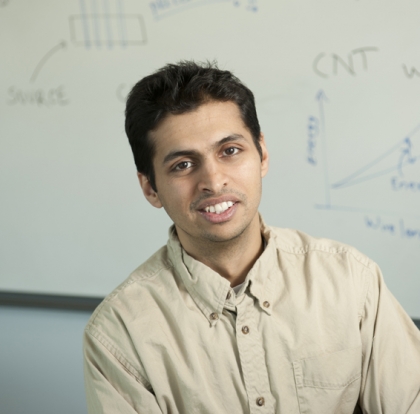
Assistant Professor Ajay Joshi (ECE) is one of seven College of Engineering faculty members to receive a 2011 Dean's Catalyst Award.
College of Engineering research projects in nanofluidics, integrated circuit design, data-driven healthcare management and Terahertz radiation generation are set to take off, thanks to the Dean’s Catalyst Awards (DCA) grant program. This year four research teams will each receive up to $50,000 in DCA funding to develop novel techniques to investigate these topics.
Established by Dean Kenneth R. Lutchen in 2007 and organized by a faculty committee, the annual Dean’s Catalyst Awards program encourages early-stage, innovative, interdisciplinary projects that could spark new advances in a variety of engineering fields. By providing each project with seed funding, the awards give full-time faculty the opportunity to generate initial proof-of-concept results that could help secure external funding.
This year’s DCA-winning projects promise to improve the nation’s healthcare, defense, information and communications systems.
Leveraging their respective skills in computational modeling of nanomaterials and fabrication/testing of nano-electromechanical systems, Assistant Professor Harold Park and Associate Professor Kamil Ekinci (both ME, MSE) will study the ability of graphene, the world’s only known 2D material, to increase fluid flow through nanoscale channels. By utilizing the hydrophobic properties of the world’s thinnest known material (graphene is composed of a single layer of carbon atoms) to significantly enhance the fluid flow rate in confined, nanoscale channels, the researchers aim to improve the performance of nanofluidic devices and lab-on-a-chip technologies. Potential application areas include biological and chemical sensing, homeland security and healthcare.
Combining low-power circuit and micro-architecture design techniques with ideas from coding and information theory, ECE Assistant Professors Ajay Joshi and Bobak Nazer plan to develop a new approach to digital VLSI (very large scale integrated circuit) design that tolerates errors at the device level while maintaining global reliability at the architectural level. Rather than paying the ever-increasing energy and area costs required to keep all devices well-behaved, the researchers intend to allow individual transistors to be “noisy.” The goal is to develop an architecture that exploits feedback and redundancy to maintain nearly the same end-to-end reliability and performance as today's designs while consuming much less energy.
Professor Ioannis Paschalidis (ECE, SE), Daniel Newman, BUMC assistant professor of medicine and Boston Medical Center (BMC) chief medical information officer, and Shiby Thomas, BMC director of enterprise analytics, will pursue a comprehensive and systematic approach to intelligently processing Electronic Health Records (EHRs) and directing physician attention to preventing serious medical conditions. Using algorithms that assess patients for disease risk and trigger physician actions based on their risk classification, and wireless body sensors that dispatch medical information to the clinic in near real-time, the researchers’ proposed system could significantly reduce costs and improve efficiencies in the U.S. health care system.
Despite major application opportunities in medical and chemical imaging and security screening, there are few sources that emit electromagnetic radiation in the Terahertz (THz) range (0.3-10 trillion Hz). Combining their respective expertise in graphene fabrication and THz radiation studies, Professors Anna Swan and Roberto Paiella (both ECE, MSE) propose an entirely novel way of generating THz radiation that, unlike current state-of-the-art methods, is not limited by intrinsic material properties. They plan to develop a “tabletop cyclotron source” of THz light that exploits the excellent electron transport properties of graphene to produce radiation in the Terahertz range.
“The Dean’s Catalyst Award is an ideal platform for exploring novel ideas that are promising, but need more probing to understand their true potential,” said Joshi. “We are grateful for this opportunity to refine our ideas and develop preliminary results before applying for external funding.”
Research Focuses on Getting Wireless Networks to Fix Themselves
By Jason L London
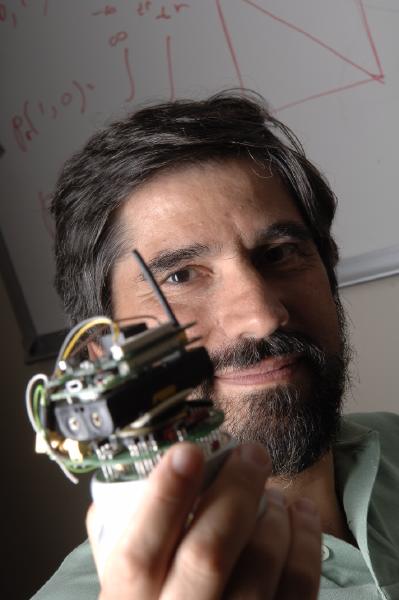
Professor Christos Cassandras is the principle investigator on a four-year, $2 million National Science Foundation grant to advance the reconfiguration of autonomous networks. The main test bed for this research will be OpenAir Boston, a private, non-profit organization that will oversee the impending wireless network over the city of Boston.
Professor Christos Cassandras is the principle investigator on a four-year, $2 million National Science Foundation grant to advance the reconfiguration of autonomous networks. The main test bed for this research will be OpenAir Boston, a private, non-profit organization that will oversee the impending wireless network over the city of Boston.
Professor Christos Cassandras is the principle investigator on a four-year, $2 million National Science Foundation grant to advance the reconfiguration of autonomous networks. The main test bed for this research will be OpenAir Boston, a private, non-profit organization that will oversee the impending wireless network over the city of Boston.
The National Science Foundation has awarded Boston University Professor Christos Cassandras (MFG), Associate Professor Ioannis Paschalidis (MFG) and CAS Computer Science Professor Azer Bestavros a four-year, $2 million Emerging Frontiers in Research and Innovation (EFRI) grant to advance the reconfiguration of autonomous networks in the wake of an unexpected problem or system error. The grant, Cassandras said, will be used to develop software that will allow a network to reset itself after an unexpected technical problem or sudden changes in operating conditions. The main test bed for this research will be OpenAir Boston, a private, non-profit organization that will oversee the impending wireless network over the city of Boston.
The project’s research aims to create a fundamental understanding of system reconfigurability.
“This research project is innovative and an excellent complement to our objectives,” Pamela Reeve, chief executive officer of OpenAir Boston, said. “The proposed research will play a crucial role in reaching the goal of a responsive enterprise able to adjust to changing conditions.”
Additional research will be done by placing sensor nodes on trucks inside the warehouse of the Raymond Corp., one of North America’s largest manufacturers and suppliers of electric lift trucks.
“The goal is to develop a network that has the ability to automatically reconfigure itself,” Cassandras, the project’s principal investigator, said. “If a transceiver breaks down, a battery runs out or something fails because of weather, the network will have the capability to reconfigure itself and continue supporting its mission without anyone physically having to correct the problem.”
The opportunity to apply this research to a major urban environment like Boston impressed the National Science Foundation, Cassandras said.
“The fact that we had a test bed over the city of Boston was a unique idea,” he said. “The idea itself is certainly different and ambitious, as is the collaborate effort of Boston University and a private industry like OpenAir Boston.”
Because the OpenAir Boston system will initially incorporate only basic capabilities of a wireless network, the grant will allow the network to add a reconfigurability feature that will incorporate extra intelligence otherwise difficult to do when the wireless network is fully operational.
“This will help make the design robust from the beginning,” Cassandras said. “To retroactively impart extra data to any system is difficult. This will allow us a much better chance of success.”
Much of the grant’s research will be conducted by the Center for Information and Systems Engineering (CISE), a systems engineering collaboration between faculty from the College of Engineering, the College of Arts and Sciences, and the School of Management. CISE will be the main point of collaboration between Boston University and OpenAir Boston. Two professors from the University of Massachusetts will also collaborate on the grant.
“This grant is another success story for CISE,” Cassandras said. “Our hope is that Boston University and CISE become the heart soul of the wireless network in Boston.”
